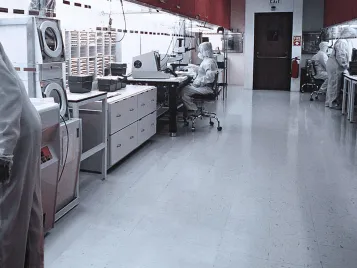Colorex tiles are cut from solid blocks of highly compressed material. The pressing process takes place in a multi-bay static press where high pressure and high temperature are applied for a 50 minute period. Sheet product cannot be made using this process.
ESD & Cleanroom FAQ's
These are the frequently asked questions about our ESD & Cleanroom flooring solutions.
If you would like to download technical/environmental specifications, BRE results, NBS specification, please visit the ESD & Cleanroom Flooring downloads.
For installation, cleaning & maintenance guides and videos, please visit the Installation & Floorcare section.
View our green certifications on our Creating Better Environments page.
-
Why is Colorex not available in sheet?

-
When do we use SD and when do we use EC?
The difference between SD and EC is in the tightly controlled composition of the black chip coating which makes the product more conductive or less conductive. Usually, the electrical resistance requirements of a conductive floor are defined by the end user. EC is the more conductive of the two and is required for electronic industry application and explosion hazard areas.
SD is often used for less sensitive but still demanding areas such as operating theatres and server rooms. Pharmaceutical and Life science applications usually do not require ESD protection.
-
What do resistance values expressed in Ohm mean?
Across all norms and standards: Resistance to earth: anything below 10E6 Ohms is conductive, anything above 10E6 up to 10E8 Ohms is dissipative. Anything above 10E9 Ohms is insulating. Resistances below 50,000 Ohms are forbidden for safety reasons.
-
Where does the 50,000 Ohm come from as the lower limit of conductivity?
If one touches an AC current up to 500V while standing on a floor with electrical resistance to earth lower than 50,000 ohms there is a risk of injury or even death as a result of electric stock.
-
What test defines the dimensional stability of Colorex and what does the testing involve?
Dimensional stability is the ability of a thermoplastic flooring tile to return to its original physical dimensions after extreme material stress by simulated aging (6 hours in an oven at 80° C) Dimensional stability is expressed in % deviation from the original dimensions, testing method is EN 434.
The dimensional stability of Colorex is always ≤ 0.05% in both directions according to EN 434, meeting and exceeding the industry standard for tiles.
-
How is conductivity of a floor measured?
Any accredited body as assigned by the end user or contractor can measure the floorcovering against several standards (IEC 61340-4-1, EN 1081, ANSI/ESD S7.1), depending on country. Our technical data lists the values of our floorcoverings in accordance with the above standards. Measuring is done by measuring in Ohms how much opposition to the flow of low voltage electricity is provided by the floor, between an electrode placed on the floor (entry point) and the connection to earth (exit point).
Testing is carried out by applying a charge of 10 V, 100 V or 500 V DC, depending on the standard used. Most widely used is 100 V in Europe, while USA and various Asian counties also measure with 10 V.
-
It there a lifetime warranty on conductivity?
Provided the floor is installed and used/maintained properly Colorex will be conductive throughout its usefull life. This is due to the performance of conductive veins that are throughout the homogeneous structure.
-
To which rolling load does Colorex resist?
Any which can be borne by the subfloor, up to powered forklift trucks with 5,000 kg total weight rolling on air tyres. Actual operating conditions must always be taken into due account as they can affect this general indication. Installation with a 2 component epoxy is recommended if powered traffic exceeds 2,000 kg.
-
What is the chemical resistance of Colorex?
Colorex colours can be influenced by long term contact with PVC solvents such as ketones, chlorinated solvents and phtalates. e.g. Acetone. In particular cases ask for advice at Forbo Flooring.
-
Why is the surface of Colorex not coated with lacquer?
No factory coating is a distinctive characteristic of Colorex. A factory coated Colorex would not be repairable without leaving any trace. In addition, the surface of Colorex is so smooth and dense that it does not require a coating for good performance. A coating can wear off where as Colorex can be buffed to store the original appearance.

-
Does Colorex resist Iodine?
No, iodine stains any PVC. Oxidising the stains using simple household grade bleach products works fine as long as the stains are treated within a few days.
-
For conductive installation how much copper strip do you need per m² and what happens if you install more copper strip?
Rule of thumb: 1 linear metre of copper strip for every 40m² of floor, two grounding points, more copper is not necessary but does not affect conductivity results.
-
Do you need a conductive adhesive and primer?
A conductive adhesive is needed. Conductive primer is meant to support the electrical contact of the subfloor-glue-copper strip system. It is only required for insulating subfloors (e.g. wood) and recommended if workmanship is expected to be critical.
-
Do you always have to weld Colorex tiles?
Heat welding is mandatory in hygiene critical areas and strongly recommended where wet cleaning methods will be used. Seams do not influence shrinking as Colorex is made with very low plasticiser content. Please note that welding is not possible if tiles are installed in brick manner (half offset).
-
Do you also use conductive glue for skirtings and do you need to use conductive skirtings?
This is not required as there will be no foot contact with the skirtings. Skirting strips in SD are standard.